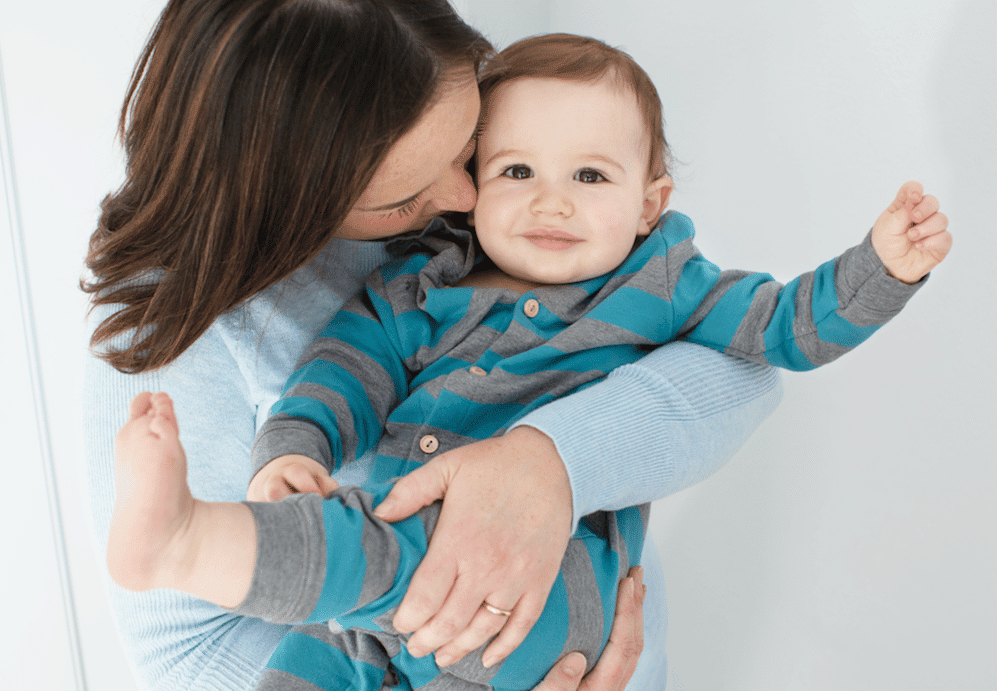Baby crying 101: All the reasons it happens and how you can help

Take a deep breath and try some of the following cry-stoppers.
Table of Contents
When we’re pregnant or awaiting adoption, we dream about our baby-to-be and always envision those beautiful Hallmark card scenes: charming baby smiling up at peaceful mother’s face.
We read books in advance of the big day about how care for a newborn: how to bathe, feed and dress her and then we feel somewhat prepared.
However, a crying baby was never part of that idyllic vision, so this takes us by surprise.
But the fact is, all babies cry. Some babies cry more than others, but they all do cry. Understanding why babies cry can help you get through this phase and respond effectively to your crying baby..
Why does my baby cry?
Simply put, babies cry because they cannot talk.
Babies are human beings, and they have needs and desires, just as we do, but they can’t express them. Even if they could talk, very often they wouldn’t understand why they feel the way they do, they wouldn’t understand themselves well enough to articulate their needs, so babies need someone to help them figure it all out.
Their cries are the only way they can say, “Help me! Something isn’t right here!”
Different kinds of cries
As you get to know your baby, you’ll become the expert in understanding his cries in a way that no one else can.
In their research, child development professionals have determined that certain types of cries mean certain things. In other words, babies don’t cry the same exact way every time. (Other child development experts, also known as mothers, have known that for millennia.)
Over time, you’ll recognize particular cries as if they were spoken words. In addition to these cry signals, you often can determine why your baby is crying by the situation surrounding the cry.
Why babies cry, and the clues that may tell you what’s up:
Hunger
If three or four hours have passed since his last feeding, if he has just woken up, or if he has just had a very full diaper and he begins to cry, he’s probably hungry. A feeding will most likely stop the crying.
Tiredness
Look for these signs:
- Decreased activity
- Losing interest in people and toys
- Rubbing eyes
- Looking glazed
- Yawning
If you notice any of these in your crying baby, she may just need to sleep. Time for bed!
Discomfort
If a baby is uncomfortable, too wet, hot, cold or squished he’ll typically squirm or arch his back when he cries, as if trying to get away from the source of his discomfort. Try to figure out the source of his distress and solve his problem.
Pain
A cry of pain is sudden and shrill, just like when an adult or older child cries out when they get hurt. It may include long cries followed by a pause during which your baby appears to stop breathing. He then catches his breath and lets out another long cry. Time to check your baby’s temperature, undress him for a full-body examination, and call the pediatrician.
Overstimulation
If the room is noisy, people are trying to get your baby’s attention, rattles are rattling, music boxes are playing, and your baby suddenly closes her eyes and cries (or turns her head away), she may be trying to shut out all that’s going on around her and find some peace. It’s time for a quiet, dark room and some peaceful cuddles.
Illness
When your baby is sick, he may cry in a weak, moaning way. This is his way of saying, “I feel awful.” If your baby seems ill, look for any signs of sickness, take her temperature and call your healthcare provider.
Frustration
Your baby is just learning how to control her hands, arms, and feet. She may be trying to get her fingers into her mouth or to reach a particularly interesting toy, but her body isn’t cooperating. She cries out of frustration, because she can’t accomplish what she wants to do. All she needs is a little help.
Loneliness
If your baby falls asleep feeding and you place her in her crib, but she wakes soon afterward with a cry, she may be saying that she misses the warmth of your embrace and doesn’t like to be alone.
Worry or fear
Your baby suddenly finds himself in the arms of Great Aunt Matilda and can’t see you—his previously happy gurgles turn suddenly to crying. He’s trying to tell you that he’s scared. He doesn’t know this new person, and he wants mommy or daddy. Explain to Auntie that he needs a little time to warm up to someone new, and try letting the two of them get to know each other while baby stays in your arms.
Boredom
Your baby has been sitting in his infant seat for 20 minutes while you talk and eat lunch with a friend. He’s not tired, hungry or uncomfortable, but he starts a whiny, fussy cry. He may be saying that he’s bored and needs something new to look at or touch. A new position for his seat or a toy to hold may help.
Colic
If your baby cries inconsolably for long periods every day, particularly at the same time each day, he may have colic.
Researchers are still unsure of colic’s exact cause. Some experts believe that colic is related to the immaturity of a baby’s digestive system. Whatever the cause, and it may be a combination of all the theories—colic is among the most exasperating conditions that parents of new babies face.
What about fussy crying?
There are plenty of times when you can’t tell if your baby’s crying is directly related to a fixable situation—hunger, a soiled diaper, or a longing to be held. That’s when parents get frustrated and nervous.
That’s when you should take a deep breath and try some of the following cry-stoppers:
No matter the reason for your baby’s cry, being held by a warm and comforting person offers a feeling of security and may calm his crying. Babies love to be held in arms, slings, front pack carriers, and (when they get a little older) backpacks.
Physical contact is what they seek and what usually soothes them best.
If you are breastfeeding, nurse them. Nursing your baby is as much for comfort as food. If not, snuggle them close and offer a bottle.
Provide motion
Babies enjoy repetitive, rhythmic motion such as rocking, swinging, swaying, jiggling, dancing or a drive in the car. Many parents instinctually begin to sway with a fussy baby, and for a good reason: It works.
Turn on some white noise
The womb was a very noisy place. Remember the sounds you heard on the Doppler stethoscope? Not so long ago, your baby heard those 24 hours a day. Therefore, your baby sometimes can be calmed by “white noise” that is, noise that is continuous and uniform, such as that of a heartbeat, the rain, static between radio stations, and your vacuum cleaner. Some alarm clocks even have a white noise function.
Let music soothe your baby
Soft, peaceful music is a wonderful baby calmer. That’s why lullabies have been passed down through the ages. You don’t have to be a professional singer to provide your baby with a song—your baby loves to hear your voice. In addition to your own songs, babies usually love to hear any kind of music. Experiment with different types of tunes, since babies have their own favorites that can range from jazz to country to classical, and even rock and rap.
Swaddle your baby
During the first three or four months of life, many babies feel comforted if you can recreate the tightly contained sensation they enjoyed in the womb.
Massage your baby
Babies love to be touched and stroked, so a massage is a wonderful way to calm a fussy baby. A variation of massage is the baby pat; many babies love a gentle, rhythmic pat on their backs or bottoms.
Let your baby have something to suck on
A breast, a bottle, pacifier, baby’s own fingers, a teething toy, or daddy’s pinkie can work wonders as a means of comfort.
Distract your baby
Sometimes a new activity or change of scenery, maybe a walk outside, or a dance with a song, or a splashy bath can be very helpful in turning a fussy baby into a happy one.
Reading your baby’s body language
Many times, you can avoid the crying altogether by responding right away to your baby’s earliest signs of need, such as fussing, stiffening her body or rooting for the breast. As you get to know your baby and learn her signals, determining what she needs will become easier for you even before she cries.
This article is a copyrighted excerpt from Gentle Baby Care by Elizabeth Pantley. (McGraw-Hill, 2003) PAGE 3





































